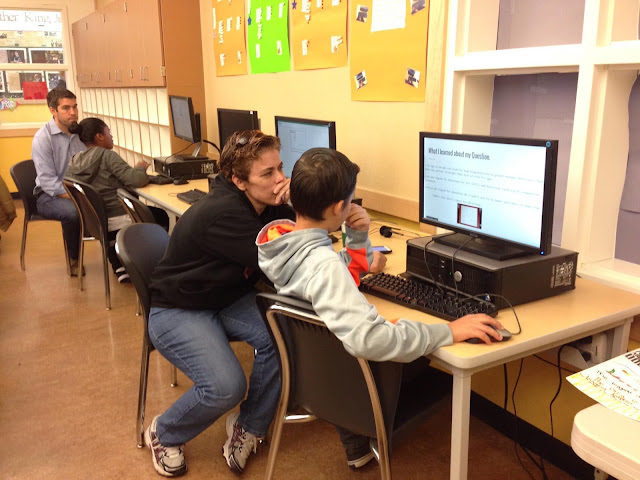Posted by Jennifer Wang, Computer Science Education Program Manager Nationally,
9 in 10 parents want their children to learn computer science (CS) but only a quarter of principals report offering CS with programming in their schools. Ever wonder what the stats look like in your state? Today, we're excited to release
new reports that take a closer look for 11 states. These reports are part of our
comprehensive multi-year research study with Gallup Inc. and cover the most populous U.S. states (CA, FL, GA, IL, MI, NC, NY, OH, PA, TX, and WI). For each state, we highlight insights about CS perceptions as well as challenges to providing CS education for all students, and we show how the state compares to the national average.
There's no silver bullet to increasing students' access and exposure to CS, but from our research, we identified four areas that we must focus on in order to move the needle. We found:
- The greatest challenges to offering CS included lack of qualified teachers for the subject matter and budget for teachers.
- Other school system barriers are a focus on testing requirements and low perceived institutional support, even with high support among parents and educators found in our previous report.
- CS offerings at schools are limited and often serve select students.
- Perceptions of what CS involves are unclear, with many principals confusing CS as basic computer literacy.
The
reports provide more detail on each state’s unique challenges. Below, we share some local initiatives tackling the four key areas identified by the research.
Empowering CS teaching Nationally, we found the #1 barrier to offering CS classes is lack of budget to hire or train teachers. At Google, we are committed to closing this gap by empowering teachers in local communities through
CS4HS, a program that has funded CS teacher professional development worldwide and in over 37 states. Support from CS4HS and the National Science Foundation enabled Marquette University in Wisconsin to provide programming to
double the number of CS teachers in the state. We also partner with
Code.org and local leaders to expand the number of CS teachers across the U.S. In Georgia, they partnered with
CEISMC at Georgia Tech as well as the Department of Education and Governor’s office to open teacher professional learning programs to the entire state. In Riverside Unified School District, the 15th largest district in California,
CS First, our free program that helps anyone—a teacher, parent or volunteer—teach kids the basics of CS, began in just a couple schools and
spread to the whole district, with the
city embracing the program to reach its community of predominantly minority students.
 |
Students in Riverside Unified School District in California learning CS First.
Photo credit: Marc Lyon Galang, RUSD Office of Communications |
Collaboratively building support with schools Unfortunately, teacher preparation isn’t the only challenge school systems face in implementing CS programs. Infrastructure and varied local implementation pose difficulties for schools. We support organizations like
ACCESS in California, which
addresses these systemic issues in CS education at a state-wide level while ensuring equity is interwoven.
TASA’s Future-Ready Superintendent Network is also doing incredible work on the ground in Texas; we recently hosted them to share and brainstorm innovative ways to transform education and bring CS to their districts. And on the city level there’s been exciting engagement coming out of the
Chicago Public Schools in Illinois through awareness building events with teachers, administrators and mayoral staff, and in New York City, Mayor de Blasio’s roll out of
Computer Science for All has ignited support for CS education across the city.
Reaching diverse students beyond school While these initiatives in formal education are exciting developments, none happen overnight. In order to broaden access for all students now, it’s equally important to engage in informal education. One such initiative we supported in Michigan is
Hello World, a camp for middle school girls founded by high schooler Christina Li. Christina was recognized with the
White House Champion of Change in Computer Science Education award and on Nickelodeon’s
The HALO Effect. Our
Computer Science Summer Institute (CSSI) provides opportunities for diverse students like
KaMar Galloway to strengthen their CS skills and prepare them for a technical career. CSSI was instrumental in KaMar’s pursuit of CS at North Carolina State University and eventually his role on our
CS First team, which aims to engage 1 million students in CS, particularly those from underrepresented groups.
Broadening perceptions and stereotypes Lastly, we need to broaden perceptions and stereotypes of CS, which
our research found are discouraging for many, especially girls and minorities. Google’s
CS in Media team works with writers, producers and studios to help create more accurate and varied storylines about CS and to diversify media portrayals of computer scientists. Recently, we partnered with the Miami International Film Festival on a
4-day seminar series on gender and racial gaps in film and tech to increase awareness and brainstorm solutions. Googlers in our Pittsburgh, Pennsylvania office annually provide 60 teachers and 650 students with a real-world look into CS. In Ohio,
HER Ideas in Motion aims to change stereotypes by providing female tech role models and project-based learning for girls across the state. In New York,
ScriptEd brings software engineers (including Googlers!) into the classroom to teach CS and connect underserved students to internships. These volunteer engineers serve as mentors to build students’ confidence and perception of the field. Both organizations received Google’s
RISE Awards for their high impact outreach.
We hope that these numerous initiatives and nonprofits will continue to drive change in communities and that the research we released today will support them by identifying potential challenges and opportunities. Stay tuned for more—we’ll be continuing our research with Gallup and this summer, we’ll be releasing two new reports focusing on demographic disparities and unconscious biases in U.S. K-12 CS education.












